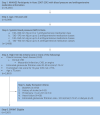Generalizability of SPRINT Results to the U.S. Adult Population
- PMID: 26562046
- PMCID: PMC5237387
- DOI: 10.1016/j.jacc.2015.10.037
Generalizability of SPRINT Results to the U.S. Adult Population
Abstract
Background: In SPRINT (Systolic Blood Pressure Intervention Trial), a systolic blood pressure (SBP) goal of <120 mm Hg resulted in lower cardiovascular disease (CVD) risk compared with an SBP goal of <140 mm Hg.
Objectives: The purpose of this study was to estimate the prevalence, number, and characteristics of U.S. adults meeting SPRINT eligibility criteria and determine the broader population to whom SPRINT could be generalized.
Methods: We conducted a cross-sectional, population-based study using data from the National Health and Nutrition Examination Survey, 2007 to 2012. The SPRINT inclusion criteria were age ≥50 years, SBP 130 to 180 mm Hg depending on the number of antihypertensive medication classes being taken, and high CVD risk (history of coronary heart disease, estimated glomerular filtration rate of 20 to 59 ml/min/1.73 m(2), 10-year CVD risk ≥15%, or age ≥75 years). Exclusion criteria were diabetes, history of stroke, >1 g in 24 h of proteinuria daily, heart failure, estimated glomerular filtration rate <20 ml/min/1.73 m(2), or receiving dialysis. Treated hypertension was defined by self-reported use of medication to lower blood pressure with ≥1 class of antihypertensive medication identified through a pill bottle review.
Results: Overall, 7.6% (95% confidence interval [CI]: 7.0% to 8.3%) or 16.8 million (95% CI: 15.7 to 17.8 million) U.S. adults, and 16.7% (95% CI: 15.2% to 18.3%) or 8.2 million (95% CI: 7.6 to 8.8 million) adults with treated hypertension met the SPRINT eligibility criteria. Among both the overall U.S. population and adults with treated hypertension, the percentage meeting SPRINT eligibility criteria increased with older age, was higher among males than females, and was higher among non-Hispanic whites compared with non-Hispanic blacks or Hispanics. Of U.S. adults eligible for SPRINT, 51.0% (95% CI: 47.8% to 54.1%) or 8.6 million (95% CI: 8.0 to 9.1 million) were not treated for hypertension.
Conclusions: A substantial percentage of U.S. adults meet the eligibility criteria for SPRINT.
Keywords: control; hypertension; population health; systolic blood pressure; treatment.
Copyright © 2016 American College of Cardiology Foundation. Published by Elsevier Inc. All rights reserved.
Figures



Comment in
-
SPRINT: To Whom Do the Results Apply?J Am Coll Cardiol. 2016 Feb 9;67(5):473-5. doi: 10.1016/j.jacc.2015.12.006. J Am Coll Cardiol. 2016. PMID: 26846945 No abstract available.
References
-
- National Heart, Lung, and Blood Institute [September 19, 2015];Landmark NIH study shows intensive blood pressure management may save lives. Available at: http://www.nhlbi.nih.gov/news/press-releases/2015/landmark-nih-study-sho....
-
- Centers for Disease Control and Prevention [September 10, 2015];National Health and Nutrition Examination Survey: questionnaires, datasets, and related documentation. Available at: http://www.cdc.gov/nchs/nhanes/nhanes_questionnaires.htm.
-
- Mirel LB, Mohadjer LK, Dohrmann SM, et al. National Health and Nutrition Examination Survey: estimation procedures, 2007–2010. Vital Health Stat. 2013;159:1–17. - PubMed
-
- Levey AS, Bosch JP, Lewis JB, et al. Modification of Diet in Renal Disease Study Group A more accurate method to estimate glomerular filtration rate from serum creatinine: a new prediction equation. Ann Intern Med. 1999;130:461–70. - PubMed
Publication types
MeSH terms
Substances
Grants and funding
LinkOut - more resources
Full Text Sources
Other Literature Sources
Medical
Miscellaneous

